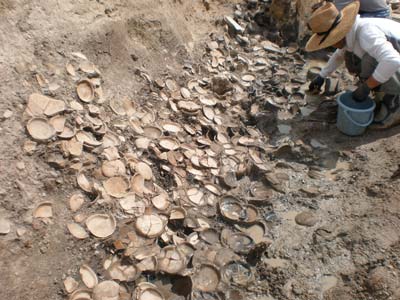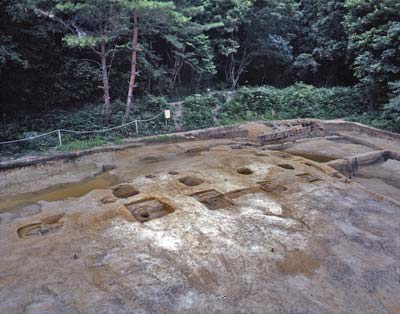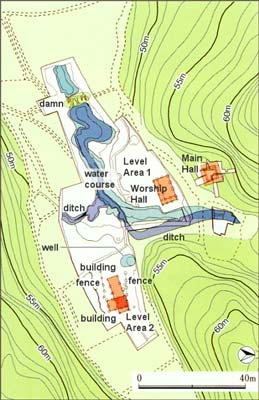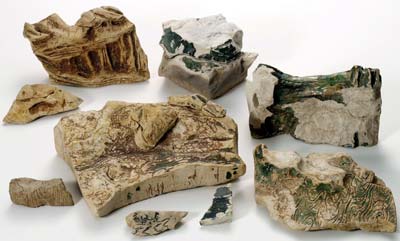Baba Minami:
A wooden writing tablet inscribed with a Man'yō poem and massive amounts of votive lamp dishes are recovered.
A mysterious forgotten temple reveals itself.

Vast amounts of votive lamp dishes recovered from a watercourse |

Ink-inscribed pottery bearing a temple name |

Main hall of the temple |

Panorama of the Baba Minami site |

Worship hall |

Features discovered at the Baba Minami site Adapted from Hakkutsu sareta Nihon rett 2010 [Excavations in the Japanese Archipelago, 2010] (Bunkachō [Agency for Cultural Affairs], ed., Asahi Shimbun Publications, 2010). |

Man'yō poem tablet |
Baba Minami Site, Kizugawa City, Kyoto Prefecture
An ancient temple built near a port
Near the border between the modern prefectures of Kyoto and Nara, in the Nara period there was a port called Izumi no tsu. Large amounts of goods from all over were loaded onto boats, brought upstream on the Yodo and Kizu rivers from Osaka bay, unloaded at Izumi no tsu, and carried overland to the Nara capital. The Baba Minami site is an ancient temple (from the middle part to the latter half of the eighth century) in a small valley along the road connecting Izumi no tsu and Tōdaiji temple.
A diversity of recovered artifacts
During excavations in 2007-08, beginning with a wooden writing tablet bearing a Man'yō poem, a variety of artifacts were recovered including many ink-inscribed pottery (with terms such as: ![]() , the name of a temple; momiji, autumn leaves; Ōdono, a term of reference for a very high official or possibly the emperor), a mountain-and-water landscape in colored glazed stoneware, Buddhist related ceramics, and roof tiles of the Nara palace style. Also, buildings, fences, and wells were detected on the slope and at the base of a hill, and a watercourse was found within the valley.
, the name of a temple; momiji, autumn leaves; Ōdono, a term of reference for a very high official or possibly the emperor), a mountain-and-water landscape in colored glazed stoneware, Buddhist related ceramics, and roof tiles of the Nara palace style. Also, buildings, fences, and wells were detected on the slope and at the base of a hill, and a watercourse was found within the valley.
A temple unknown in historical documents
From the ink-inscribed pottery it is known that at the site stood a temple designated as ![]() (but also as
(but also as ![]() , either of which could be read variously as Kamiodera, Kannōji, etc.). Incense burners thought to have been used in Buddhist ritual, plus plentiful finds of Buddhist related items such as water pitchers of a special type called jōhei, the lid of a stupa-shaped bowl, and pots in the shape of a Buddhist priest's begging bowl, along with fragments of clay sculpture inferred to have been the Buddhist Four Heavenly Kings, all back up this view.
, either of which could be read variously as Kamiodera, Kannōji, etc.). Incense burners thought to have been used in Buddhist ritual, plus plentiful finds of Buddhist related items such as water pitchers of a special type called jōhei, the lid of a stupa-shaped bowl, and pots in the shape of a Buddhist priest's begging bowl, along with fragments of clay sculpture inferred to have been the Buddhist Four Heavenly Kings, all back up this view.
How was the Man'yō wooden tablet used?
The wooden tablet with the Man'yō poem was broken off in the middle, but the surviving portion is 23.4 cm long. If the entire poem were written as a single line, the tablet would have been an extremely large item of over 60 cm in length. Accordingly, it was not just for recording the poem, but rather thought to have been used to show the poem to a large group of people so they could recite it in chorus.
The mysterious temple
From the discovery of pottery inscribed with the title Ōdono and roof tiles used to decorate the Nara palace, plus the stoneware mountain-and-water landscape which only a major temple could have owned, it is seen that some very powerful figure of the imperial court was connected with this temple.
Even though the temple remains found in this excavation are small in scale, there can be no doubt that an important court figure was involved. Quite likely large numbers of the nobility gathered at this small temple, where Buddhist services and poetry parties were held. (Iwamatsu Tamotsu)
Principal artifacts

A variety of three-colored glazed stoneware
Nara period, latter half of eighth century.
(Incense burner at rear) Length: 22.0 cm; width: 22.0 cm.
Stoneware painted with brightly colored glaze before firing was recovered in large numbers. Included are incense burners used as Buddhist ritual paraphernalia, the lid of a stupa-shaped bowl, and water pitchers.


Mountain-and-water landscape in colored glazed stoneware
Nara period, mid- to latter half of the eighth century.
(Item at center foreground in the group of objects, and in the close-up) Length: 7.0 cm; width: 5.0 cm.
Approximately 60 fragments were recovered of colored glazed stoneware shaped as water and mountains, or bearing wave patterns depicting the water's surface. Among these, there is an item depicting a fish (at center foreground in the group of objects, and in the close-up). This sculpture is thought to have originally been placed as decoration at the foot of a Buddha image. While there are no examples in the present day, similar artifacts have been recovered from excavations of major temples of the era such as Kōfukuji, Tōdaiji, and Kawaradera.

Votive lantern dishes
Nara period, mid- to latter half of the eighth century..
Diameter: approximately 12 cm.
Within the watercourse were roughly 6,000 or more discarded Haji ware dishes used as votive lamps. They probably added to the mood of Buddhist services or poetry parties. Piled up on the side of the watercourse nearest the worship hall, they concentrated at six main locations. In addition to votive lamp dishes, a variety of artifacts were recovered in great numbers from the watercourse.
